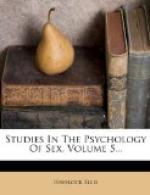Long, however, before the symbol has reached that final climax of morbid intensity we may be said to have passed beyond the sphere of sexual love. A person, not an abstracted quality, must be the goal of love. So long as the fetich is subordinated to the person it serves to heighten love. But love must be based on a complexus of attractive qualities, or it has no stability.[70] As soon as the fetich becomes isolated and omnipotent, so that the person sinks into the background as an unimportant appendage of the fetich, all stability is lost. The fetichist now follows an impersonal and abstract symbol withersoever it may lead him.
It has been seen that there are an extraordinary number of forms in which erotic symbolism may be felt. It must be remembered, and it cannot be too distinctly emphasized, that the links that bind together the forms of erotic symbolism are not to be found in objects or even in acts, but in the underlying emotion. A feeling is the first condition of the symbol, a feeling which recalls, by a subtle and unconscious automatic association of resemblance or of contiguity, some former feeling. It is the similarity of emotion, instinctively apprehended, which links on a symbol only partially sexual, or even apparently not sexual at all, to the great central focus of sexual emotion, the great dominating force which brings the symbol its life-blood.[71]
The cases of sexual hyperaesthesia, quoted at the beginning of this study, do but present in a morbidly comprehensive and sensitive form those possibilities of erotic symbolism which, in some degree, or at some period, are latent in most persons. They are genuinely instinctive and automatic, and have nothing in common with that fanciful and deliberate play of the intelligence around sexual imagery—not infrequently seen in abnormal and insane persons—which has no significance for sexual psychology.




